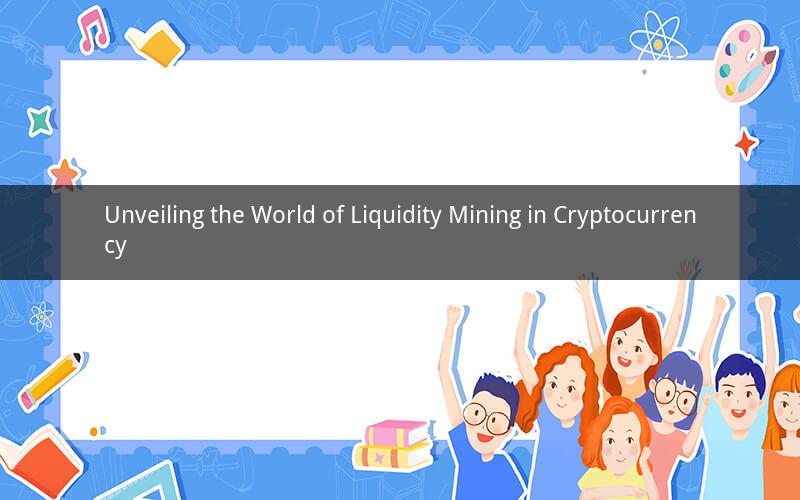
Liquidity mining in cryptocurrency has emerged as a revolutionary concept that has transformed the way investors and traders engage with the digital asset market. This article delves into the intricacies of liquidity mining, exploring its definition, benefits, risks, and its impact on the cryptocurrency ecosystem.
What is Liquidity Mining?
Liquidity mining refers to the process of earning rewards in the form of cryptocurrency tokens by providing liquidity to decentralized exchanges (DEXs). In simple terms, it involves locking up your cryptocurrency assets in a liquidity pool, which is then used to facilitate trades on the exchange. In return, liquidity providers receive a share of the trading fees generated by the exchange.
How Does Liquidity Mining Work?
Liquidity mining operates on the principle of incentivizing participants to provide liquidity to DEXs. By locking up their assets in a liquidity pool, providers ensure that the exchange has sufficient liquidity to execute trades efficiently. This, in turn, attracts more traders to the platform, leading to increased trading volume and fees.
When a trade occurs on the exchange, a small percentage of the trading fee is distributed to the liquidity providers based on their share of the pool. The distribution mechanism varies depending on the specific DEX and token pair being traded. Some platforms use a weighted average of the pool's assets, while others use a more complex formula.
Benefits of Liquidity Mining
1. High Returns: Liquidity mining offers the potential for high returns, especially when compared to traditional interest-bearing accounts. The rewards can be substantial, depending on the trading volume and the demand for the token being mined.
2. Diversification: By participating in liquidity mining, investors can diversify their cryptocurrency portfolio. They can gain exposure to various tokens without having to actively trade or hold them.
3. Incentivized Growth: Liquidity mining encourages more participants to join the platform, leading to increased trading volume and overall growth. This can benefit both the exchange and the liquidity providers.
Risks of Liquidity Mining
1. Market Volatility: Cryptocurrency markets are highly volatile, which can lead to significant price fluctuations. This volatility can impact the value of the assets locked in a liquidity pool and the rewards earned.
2. Smart Contract Vulnerabilities: Liquidity mining relies on smart contracts to facilitate the process. If a smart contract is vulnerable to hacking or bugs, it can result in the loss of funds for liquidity providers.
3. Centralization Risk: Some liquidity mining platforms may become centralized, which can undermine the decentralized nature of the cryptocurrency ecosystem. This can lead to potential manipulation and reduced security.
Impact on the Cryptocurrency Ecosystem
Liquidity mining has had a significant impact on the cryptocurrency ecosystem, fostering innovation and growth. Here are some key aspects:
1. Increased Adoption: Liquidity mining has contributed to the increased adoption of decentralized exchanges, as it offers a unique way to earn rewards while participating in the market.
2. Token Value: The demand for tokens used in liquidity mining has surged, as more exchanges and projects implement this mechanism. This has led to higher token prices and increased liquidity.
3. Enhanced Market Efficiency: By providing liquidity, liquidity mining helps improve the efficiency of decentralized exchanges, making them more competitive with centralized platforms.
Frequently Asked Questions (FAQs)
1. Q: Can I participate in liquidity mining without any prior knowledge of cryptocurrency?
A: Yes, you can participate in liquidity mining without extensive knowledge of cryptocurrency. However, it's essential to understand the risks and do your research before investing.
2. Q: Are there any risks associated with liquidity mining?
A: Yes, liquidity mining carries risks, including market volatility, smart contract vulnerabilities, and centralization concerns. It's crucial to assess these risks before participating.
3. Q: How do I choose the right liquidity mining platform?
A: When selecting a liquidity mining platform, consider factors such as the exchange's reputation, token value, trading volume, and the distribution mechanism for rewards.
4. Q: Can I withdraw my assets from a liquidity pool at any time?
A: The ability to withdraw assets from a liquidity pool depends on the specific platform and token pair. Some platforms may have lock-up periods or withdrawal fees.
5. Q: Is liquidity mining a long-term investment strategy?
A: Liquidity mining can be a short-term or long-term investment strategy, depending on your goals and risk tolerance. It's essential to evaluate your investment horizon and risk tolerance before participating.